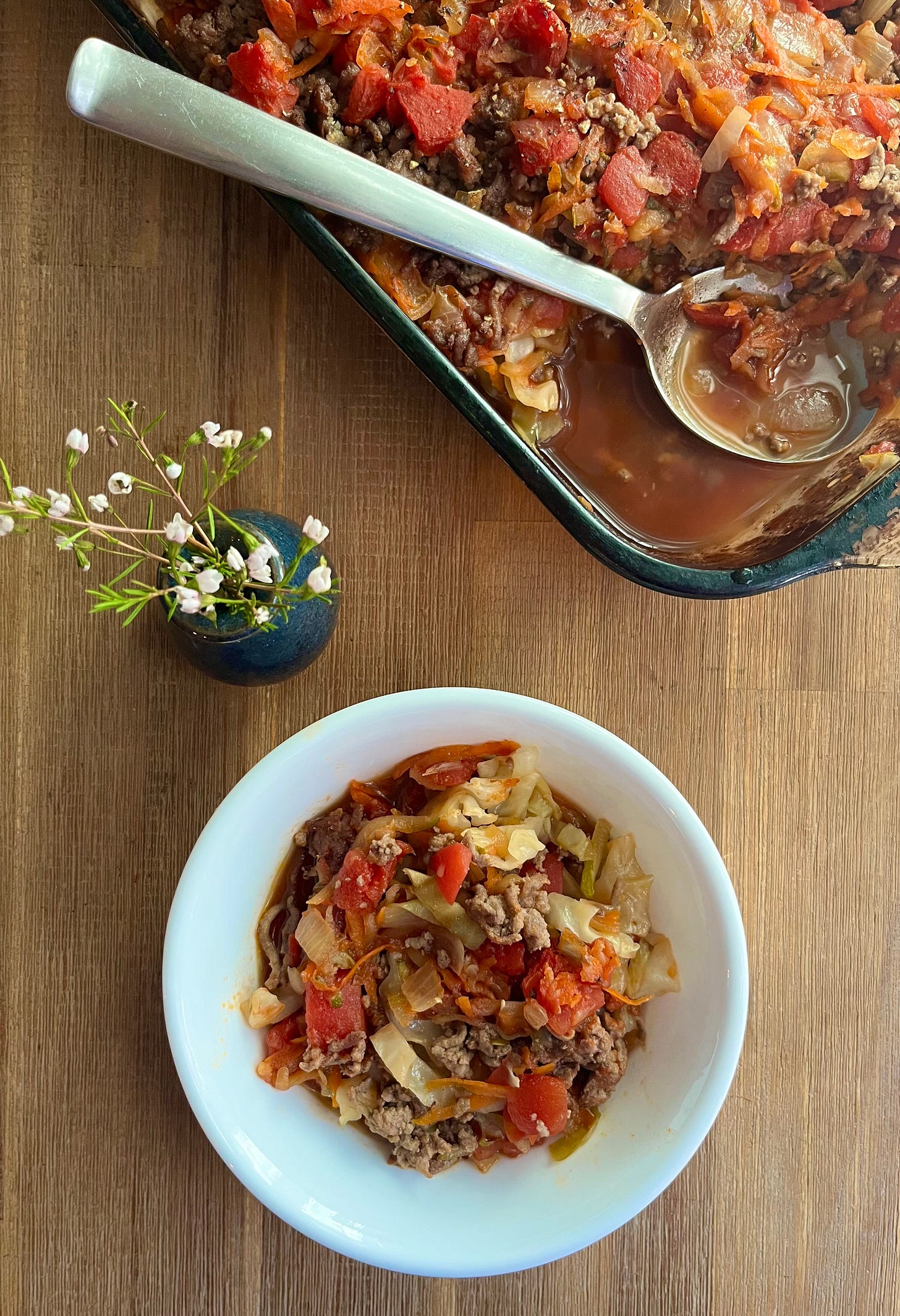Unstuffed Cabbage Rolls
A warming and traditional dish for Sukkot, faster
Hey there! If you’ve found your way here but are not yet subscribed for the paid weekly newsletter, you can do that here. You will never miss a recipe or a story, and I’ll be eternally grateful for your support.
Earlier this month, a newsletter reader left a comment that made my heart sing:
Shana Tovah! I made your stuffed cabbage rolls from The Jewish Cookbook last for the holiday and they were truly fabulous. Tasted and looked beautiful too. Used plant-based meat. They held their shape (without toothpicks!). I am never making any other stuffed cabbage recipe again!
Thank you Sherri! I’m so thrilled that the recipe was a hit. It was closely inspired by the cabbage roll recipe shared with me by a friend (and also a newsletter reader—hi Beth!) It was an honor to include Beth’s family’s recipe in The Jewish Cookbook, and I agree it truly is the best of the best—warm, comforting, and the perfect balance of tomato-y, sweet, and sour.
I love stuffed cabbage, particularly on Sukkot when it is traditional to serve stuffed foods to symbolize the abundance of the harvest season. But reading Sherri’s comment made me realize I haven’t actually made it in years. That’s in large part because making proper stuffed cabbage takes a significant amount of time and work. You have to boil the head of cabbage until the leaves turn pliable, then carefully separate each leaf from the core. Then you painstakingly fill and form each roll by hand. As much as I enjoy eating them, as a working parent with young kids, I am simply not in my prime stuffed cabbage-making years.
So this week, I have a recipe for Unstuffed Cabbage Rolls that brings you all the cozy flavor of stuffed cabbage—just a heck of a lot faster. It layers softened cabbage and ground beef in a baking dish, covers it in a veggie-packed sweet and sour tomato sauce, and bakes it until its bubbling. You can spoon the hearty casserole over rice, egg noodles, mashed potatoes, or whatever starch you prefer. It would make a delicious addition to your holiday table on Sukkot, but it is also simple enough to enjoy for a weeknight dinner.
I’ve shared the recipe below for paid subscribers. But first, here’s an excerpt from an article I wrote for Taste a few years back about the centrality of stuffed vegetables across Ashkenazi, Sephardi, and Mizrahi Jewish cuisine:
The secret to understanding the heart of almost any cuisine is to seek out its ugliest foods. To hell with impressing the company or collecting Instagram likes. The ugly foods—the dishes cooked beyond all recognition, hopelessly collapsing upon themselves and leaving behind an unsightly ring of burnt sauce around the perimeter of the pot—are so deeply delicious, looks are beside the point.
One thing that nearly all diasporic [Jewish] communities, from Romania and Poland to Syria, Morocco, and India, have in common is a deep affection for stuffed vegetables—a culinary technique that transforms a bit of meat and starch into a soulful and seductive (if textbook unattractive) centerpiece.
Called memulaim, or “stuffed ones” in Hebrew, stuffed vegetables technically fall into three distinct categories of dishes. The first includes vegetables, like zucchini, tomatoes, beets, and eggplants, that get painstakingly hollowed out or that have a natural cavity (like bell peppers), and are then filled. Stuffed vegetables made from leaves (most commonly grape leaves, cabbage, or Swiss chard) that are rolled burrito-style around a filling represent the second category. Stuffed onions arguably belong in this category, since individual layers of the onion are steamed off and used as wrappers. A third, lesser-known category includes dishes where the stuffed vegetable is coated in egg and flour and then fried before being braised in a flavorful sauce—like the North African dish Libyan mafroum (made from a potato that is slit nearly in half and stuffed) and Moroccan t’ajines d’artichouts farcis (stuffed artichokes).
Each community prepares memulaim a bit differently. Some versions are stuffed with ground beef and bread crumbs; others with ground lamb and rice or finely chopped mushrooms and kasha. Some get stewed in sauces soured by pomegranate molasses or tamarind paste; others with lemon juice or sour salt. And they are alternately spiced with cinnamon, allspice, and dried mint, or brought to life with heaps of chopped fresh dill or parsley. But prepare them they do, particularly in families lucky enough to have a skilled home cook or two around.
Primarily served on festive occasions—at Friday night dinner or holiday meals, and after synagogue on Saturday mornings—these dishes are bound up with the warm nostalgia of family and celebration.
A Sukkah Grows in Brooklyn



Just for fun, I thought I’d share our family’s sukkah. This is our second year of building a sukkah on our teeny tiny Brooklyn terrace. This year, we built it in our pajamas while listening to the Mets/Dodgers game and bundled up because it was so chilly! Our neighborhood is filled with sukkahs, from plain wooden huts to remarkably elaborate structures. We made ours from easy-to-assemble PVC pipes (smart thinking by Yoshie), water-proof shower curtains, and zip ties, and decorated it with real gourds, fake flowers from the dollar store, and homemade paper chains. Everyone helped either build or decorate, and I think it turned out so great. Will it fit our entire family for a meal at one time? Maybe. Just barely. But the vibes are impeccable.
Unstuffed Cabbage Rolls
Recipe notes: Start with a head of cabbage rather than bagged shredded cabbage, which is shredded to fine for this dish. You are looking for slightly larger, meatier shreds rather than thin coleslaw shreds. Also, I use Diamond kosher salt, which is less salty than both table salt and Morton’s kosher salt. If you are using either of the latter, drop the salt amount down to about 1 1/2 teaspoons total, then add more as needed.
Serves 8
Keep reading with a 7-day free trial
Subscribe to The Jewish Table to keep reading this post and get 7 days of free access to the full post archives.



